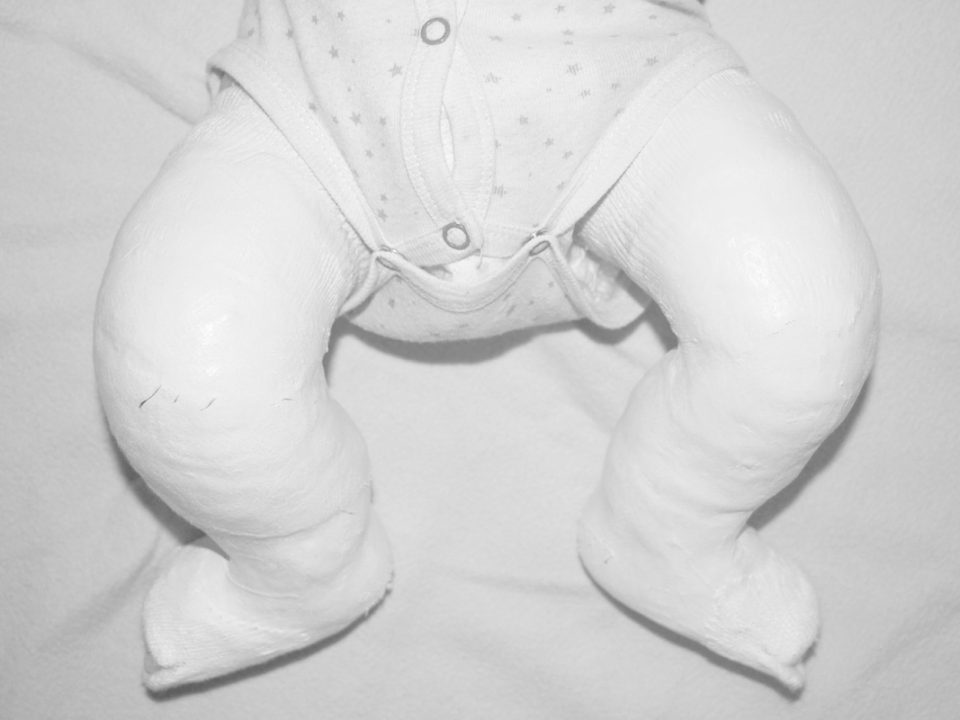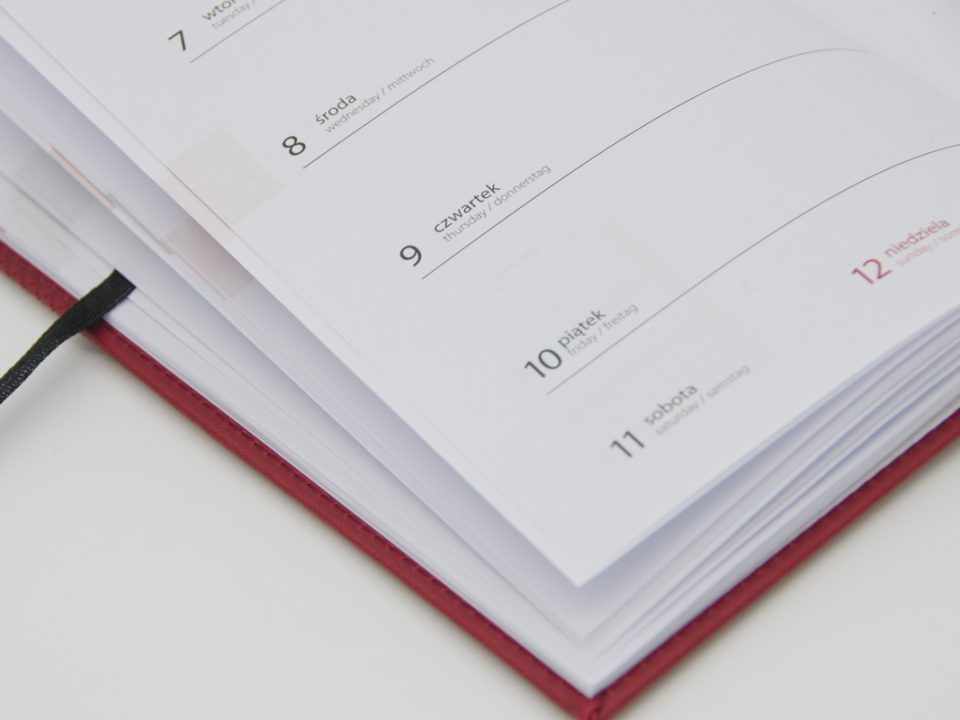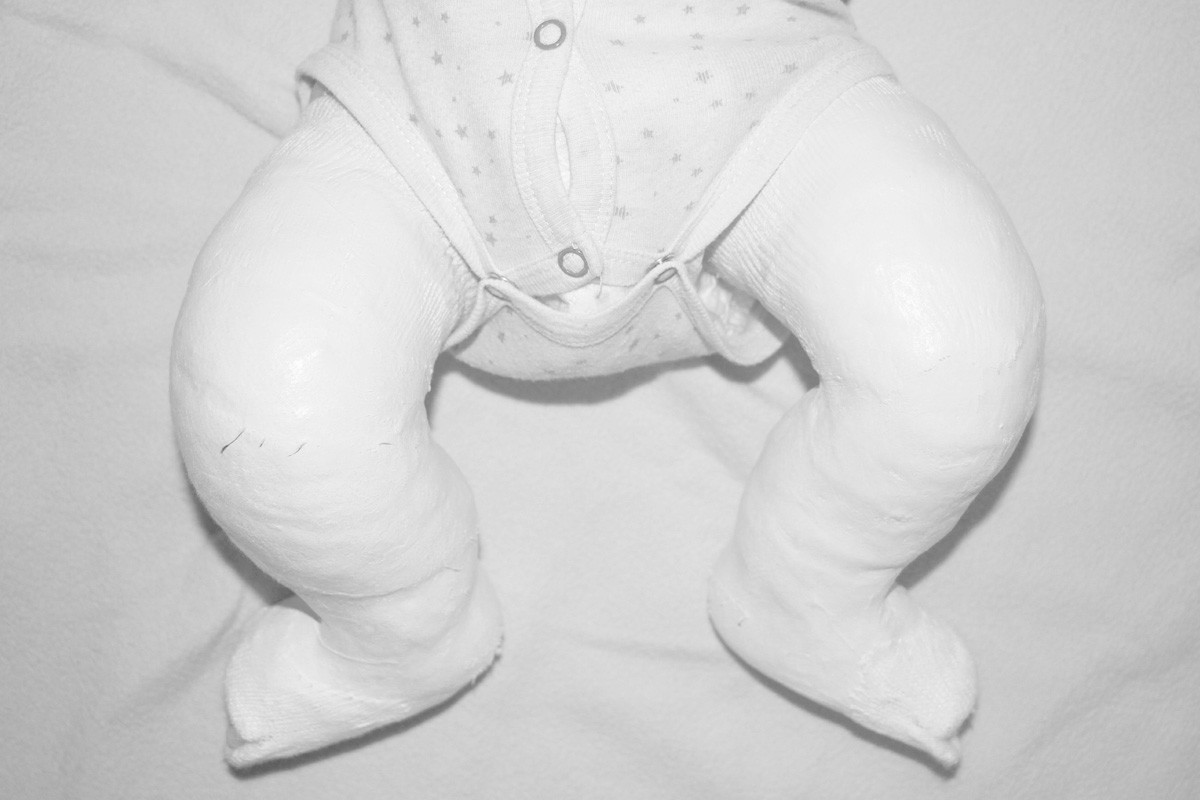
The shape of the plaster cast does matter
28 November 2021The cast plays an important role in the Ponseti method. When it is applied, a doctor corrects a foot/feet of a child. However, it is not “any” cast applied “somehow”, but a specific cast, put in a specific manner, by specific persons.
When we talk about applying plaster casts in the Ponseti method, we need to realize that it is not “any” cast, which can be put “somehow” by “someone”, who has some free time in a medical unit or in a ward. It is not applied by an “accidental” person. When we think this way, there are either no results or they are grotesque and end in a failure. We get caricatures instead of feet. Is it what we are looking for? Then the high-sounding phrase “Primum non nocere” loses its meaning.
We would like to draw your attention to incorrect casts today, which we often observe as casts applied “according to the Ponseti method” by specialists. However, the truth is that none of them is correct and compliant with the treatment method. Before we move on to the main topic of our article, just to remind you:
PROGRESS
Each cast brings change to foot presentation. It means that each subsequent cast places a foot in a different position, bringing it closer to its natural and “healthy” shape. It can be observed easily, while looking e.g. at the picture below, which shows the positions for each applied subsequent cast. Where this is not the case – treatment is wrong.
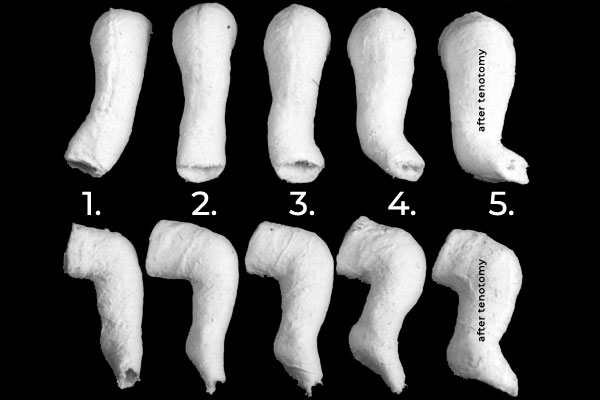
Each time new cast “positions” a foot externally – external foot rotation should change by about 10-15°. The last cast (before the percutaneous tenotomy of the Achilles tendon) should be placed in the external rotation of about 70° (atypical and complex feet have other norms).
WHO?
Casts are only applied by a qualified paediatric orthopaedist, who knows the Ponseti method well and his assistant (a plastering technician trained in correct plastering in this method). No one else should do it! A parent is also active at this stage, who holds a child in such a way to stop the child from moving and above all, diverting his or her attention from what is going on, soothing the child and giving him or her sense of security.
MATERIAL
Above all, cast applied in the Ponseti method is standard, white cast (mineral, non-synthetic, not fiberglass and modern light perforated plaster, etc.) on the basis of calcium sulphate, namely cast, which you could have seen in your life. However, there is a little “catch” here. This is quick-setting cast, the so-called plaster of Paris, namely the type of cast used in modelling or moulding. Why isn’t the traditional plaster the best material?
- the traditional cast can be modelled and shaped very well and THIS IS ESSENTIAL – therefore THE SHAPE OF THE PLASTER CAST DOES MATTER
- it is cheap;
- it has been common and known for many years
As cast modelling in the Ponseti method is essential and it must be precise, traditional plaster is suitable for this purpose, as it offers a lot of forming possibilities. This material is very ductile. The so-called quick-setting plaster bandages are used during plastering. A plaster bandage is nothing else, but the cast placed on gauze (bandage) and wound on a reel (roll).
THE DETAIL METHOD
The Ponseti method is actually “the detail method”, as thanks to them we can talk about progress in treatment of a congenital clubfoot. The proverb “the devil is in the details” suits here and it can be applied widely. There can be numerous complications in treatment, no progress and postponement of child’s fitness, if these “details” are not known and the Ponseti method is treated “with neglect” or not know at all and confused with other methods or … modified.
The so-called modelled plaster is used in this method, which comes from the technique of prof. Lorenzo Böhler – a traumatologist from Vienna. The Böhler method was based on possibly autonomous putting of the broken bones or joints together and immobilizing them in the plaster cast placed in such a way, which enabled early immobilization of a patient and then his or her quick recovery without any procedures, rehabilitation or long convalescence. It required precise plaster modelling in strategic places. This technique was assimilated by Dr Ignacy Ponseti in his clubfoot treatment method.
THE SHAPE OF THE PLASTER CAST DOES MATTER
We wrote a short article some time ago that THE SHAPE OF THE PLASTER CAST DOES MATTER and it is of great importance! Check this article. You will undoubtedly see some significant differences in relation to examples, which we will provide here. We want to show you incorrect casts today, which are put by physicians, plastering technicians, physiotherapists or third parties.
LONGUETTE
The longuette is a half-cast (semi-cast) in other words, most commonly in a gutter form (it has a shape of a letter U in the cross-section), which is applied to partial and temporary limitation of limb movements, its stiffening during its swelling, open fracture, when it is not possible to put a full cast due to the reasons, which have been mentioned before.
Why isn’t a longuette a good idea for children with clubfeet? As it corrects nothing. It is useless. It has no “power” to maintain redressment, which has been made earlier. However, it should be noted here that the cast is modelled in a specific way, in specific places: the ankle areas, the talus head, the heel, the toes, the knee, and the thigh. The author of this method writes about it:

“Proper molding of the clubfoot necessitates a celar visualization of the position of each one of the bones in the foot. The plaster cast must be molded with gentleness and anatomical precision.”
— Dr. Ignacy V. Ponseti
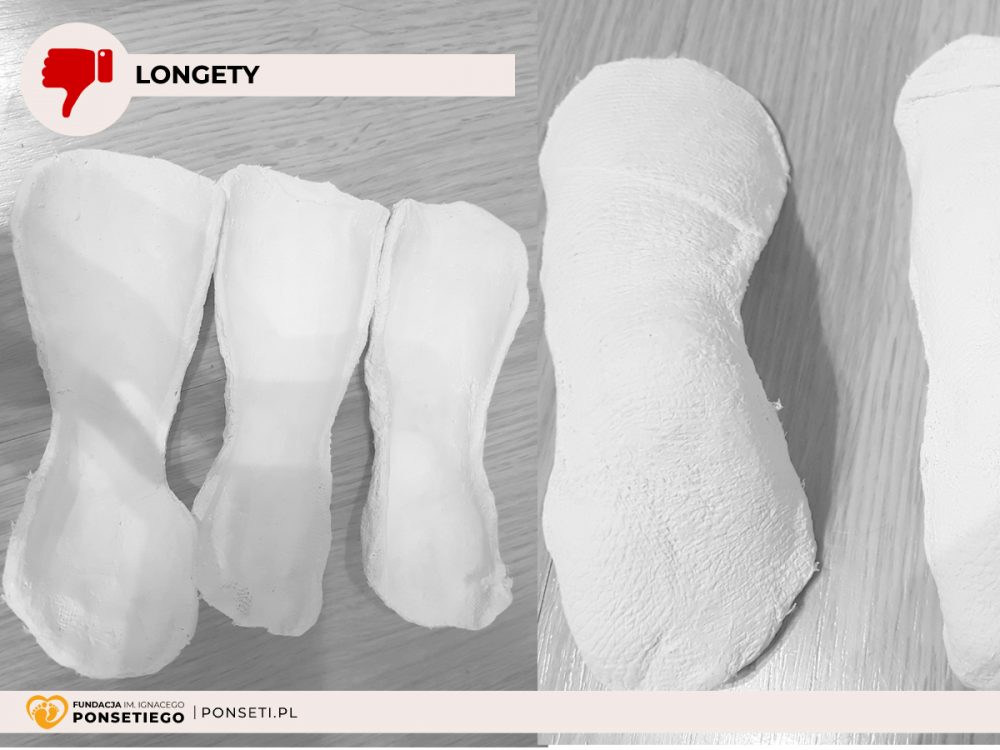
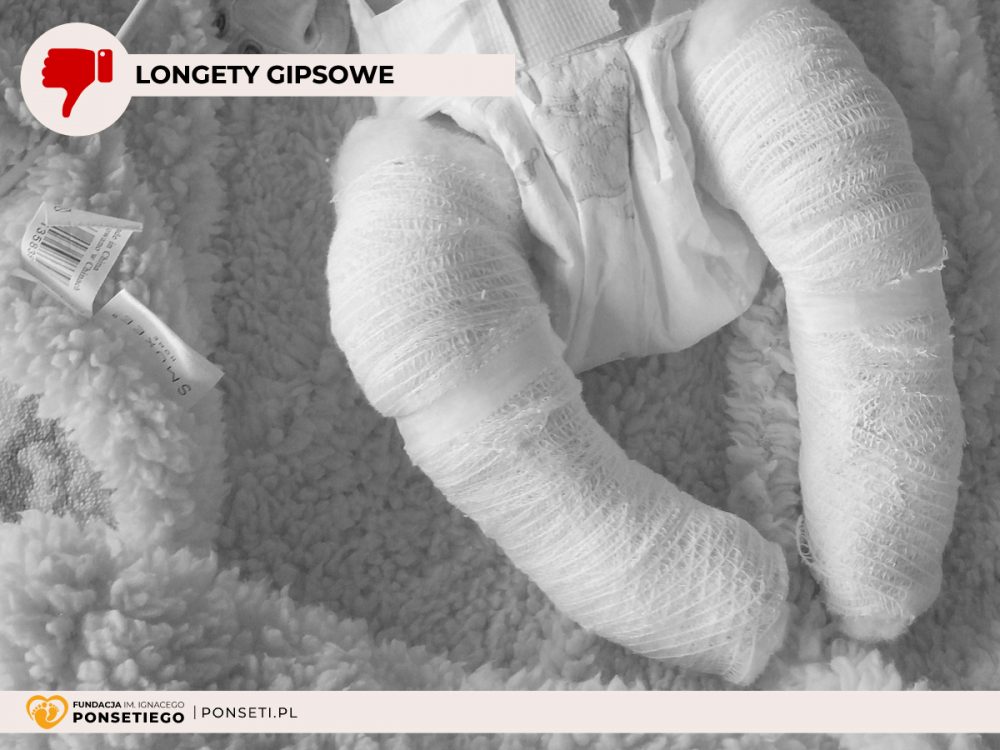
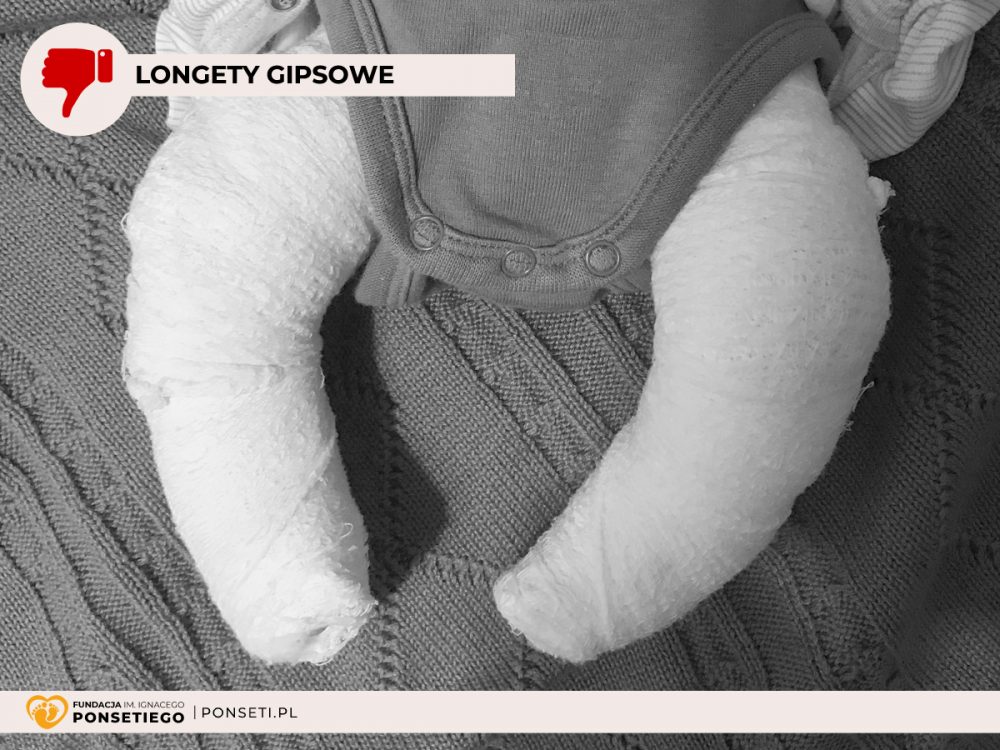
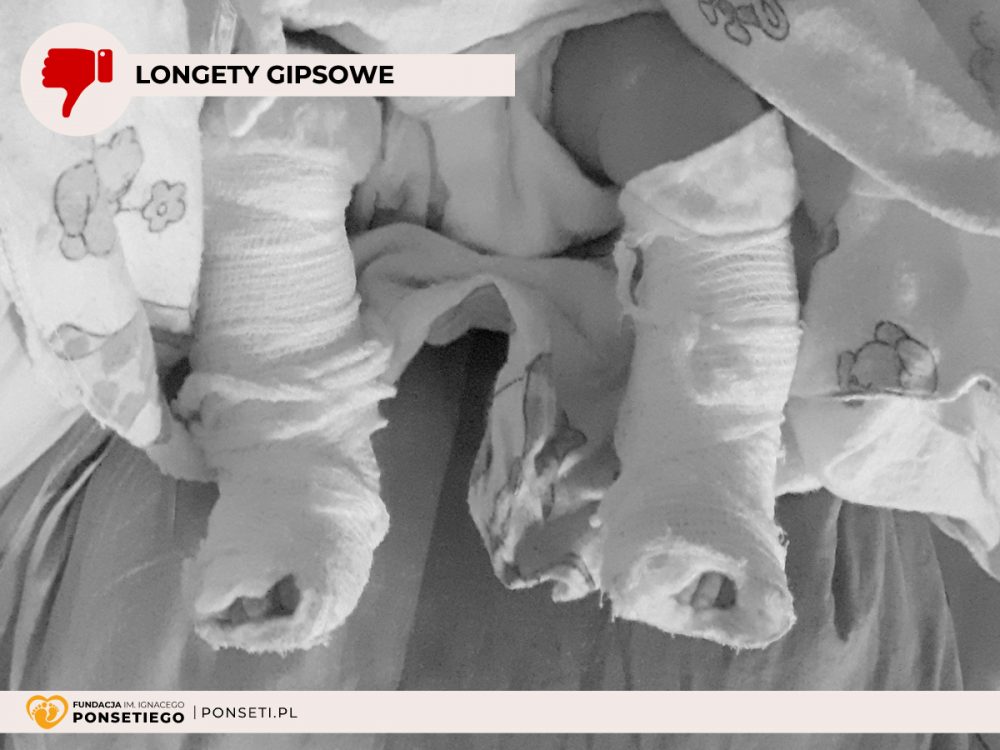


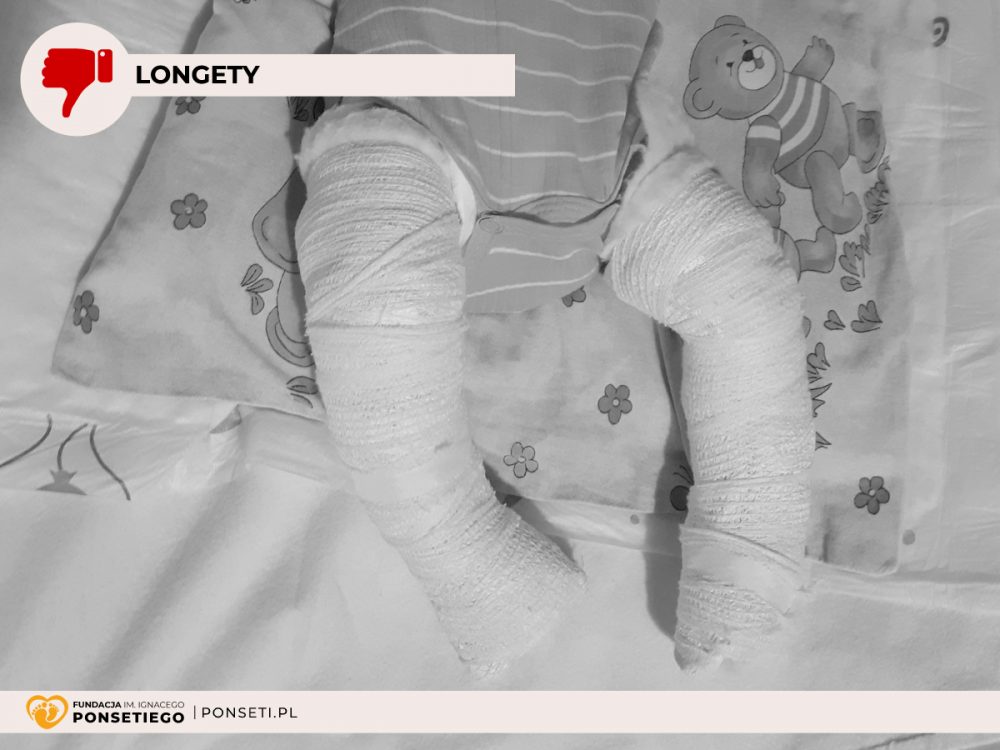
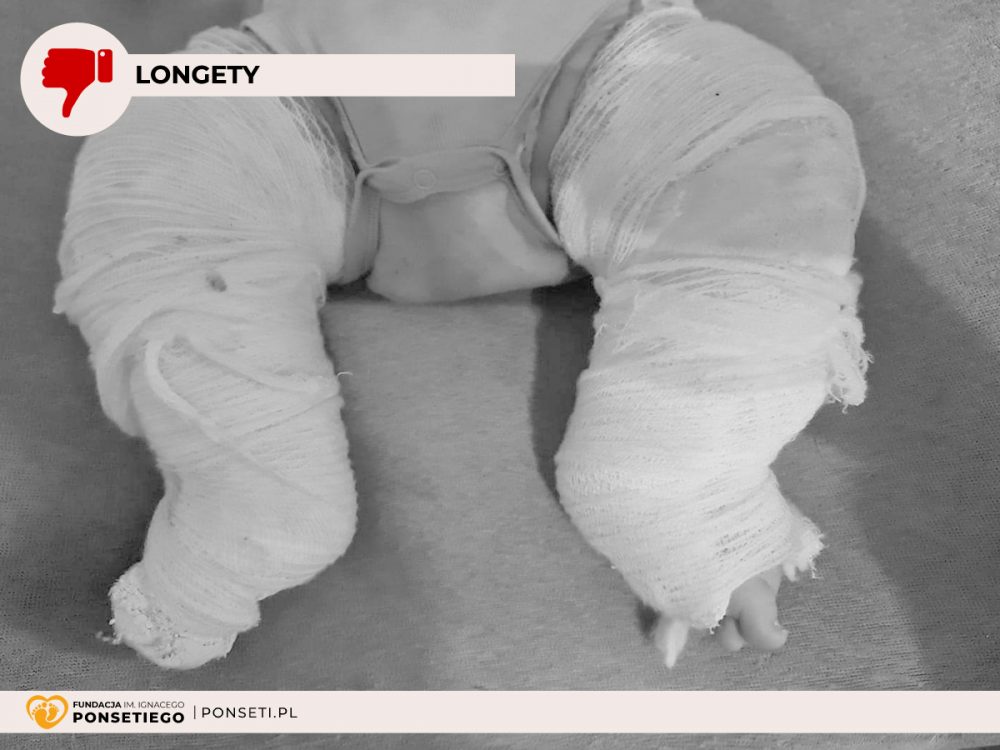
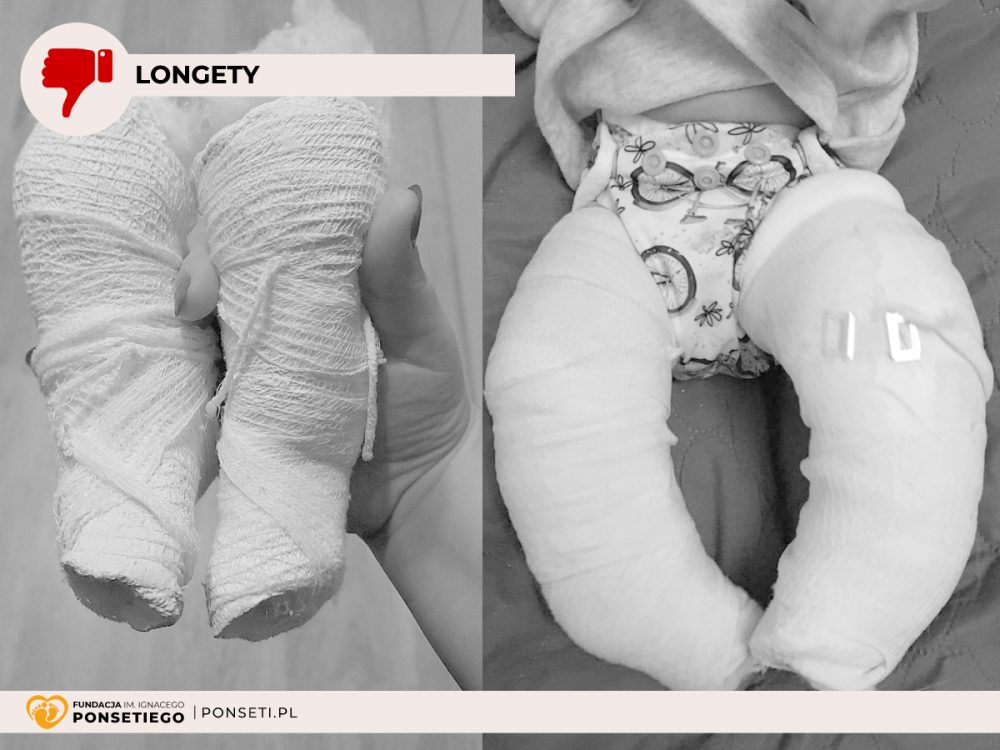
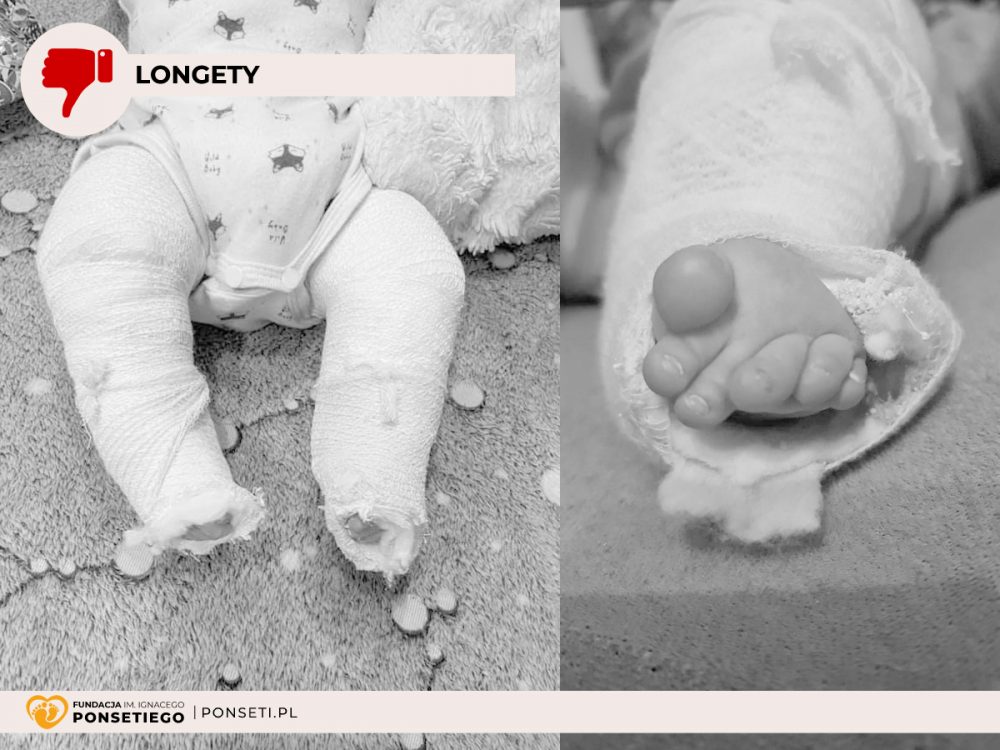
SHORT CASTS
We talk about short cast, if it only covers a foot and an ankle and sometimes also a shin or a calf, ending under a knee.
Why isn’t the short cast recommended for children with clubfeet? According to functional anatomy and foot biomechanics, it is not possible to rotate a foot, when the short cast is used, and more precisely, the calcaneus under the talus, if this mechanism is not stabilised by bending a leg in a knee and its stopping in this position. As the calcaneus is blocked under the talus, its release is possible only, if the foot is abducted in supination. If the knee is not immobilized in the cast under the angle of 90° (for atypical and/or complex foot: 110-120°), the whole subtalar complex rotates to the inside, as the tibial bone is followed, which directs towards the inside (internal tibial torsion).
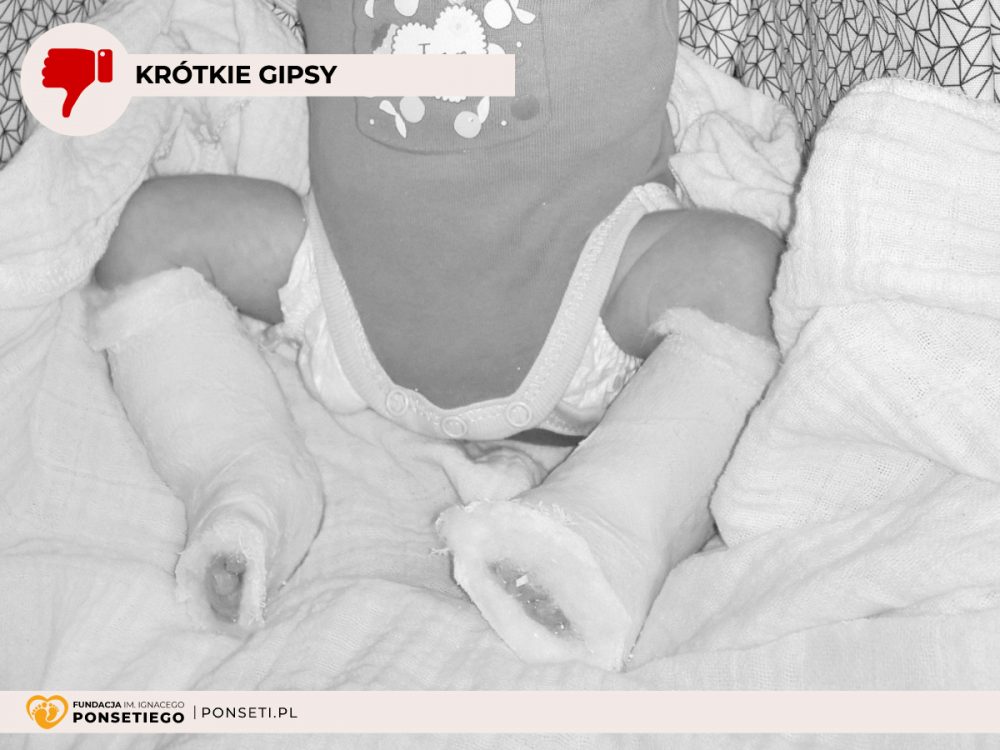
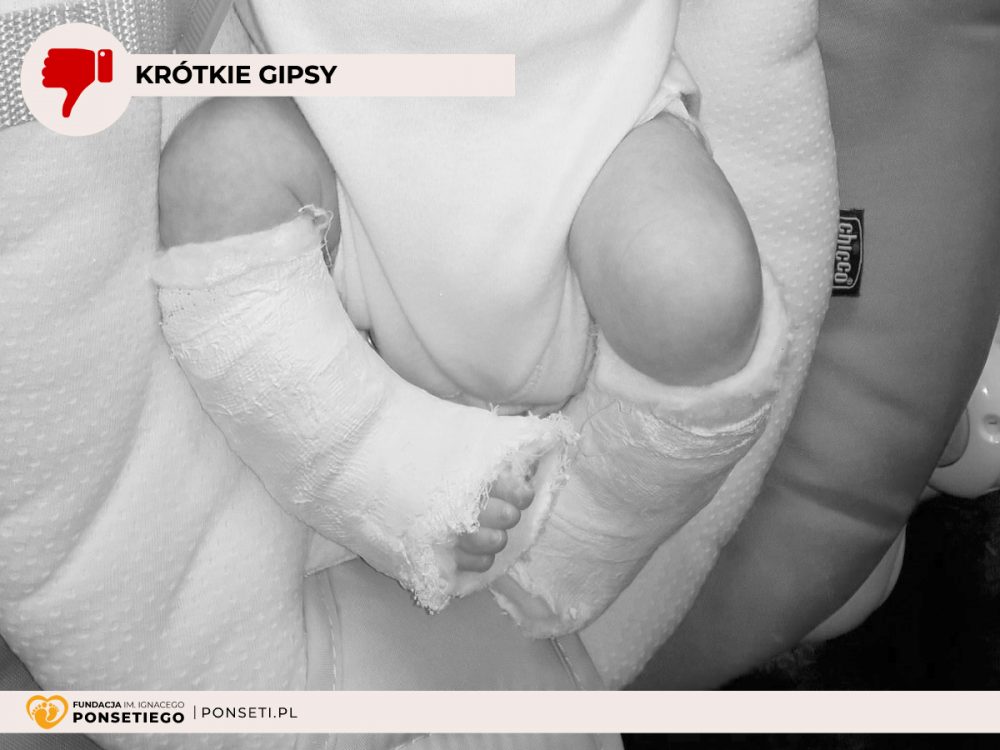


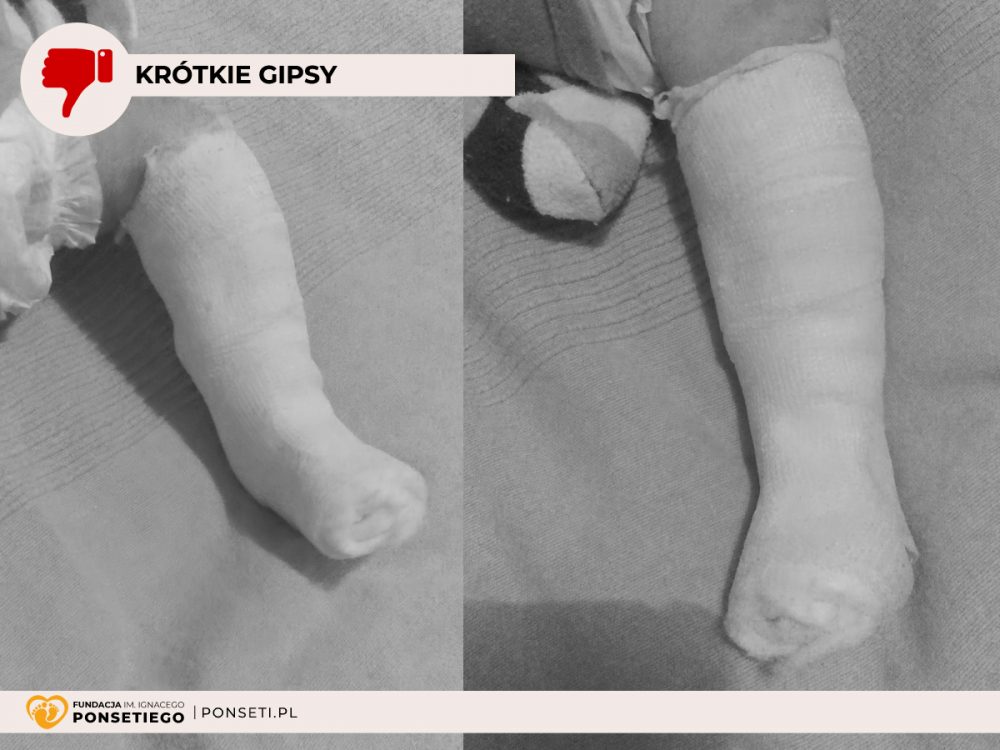
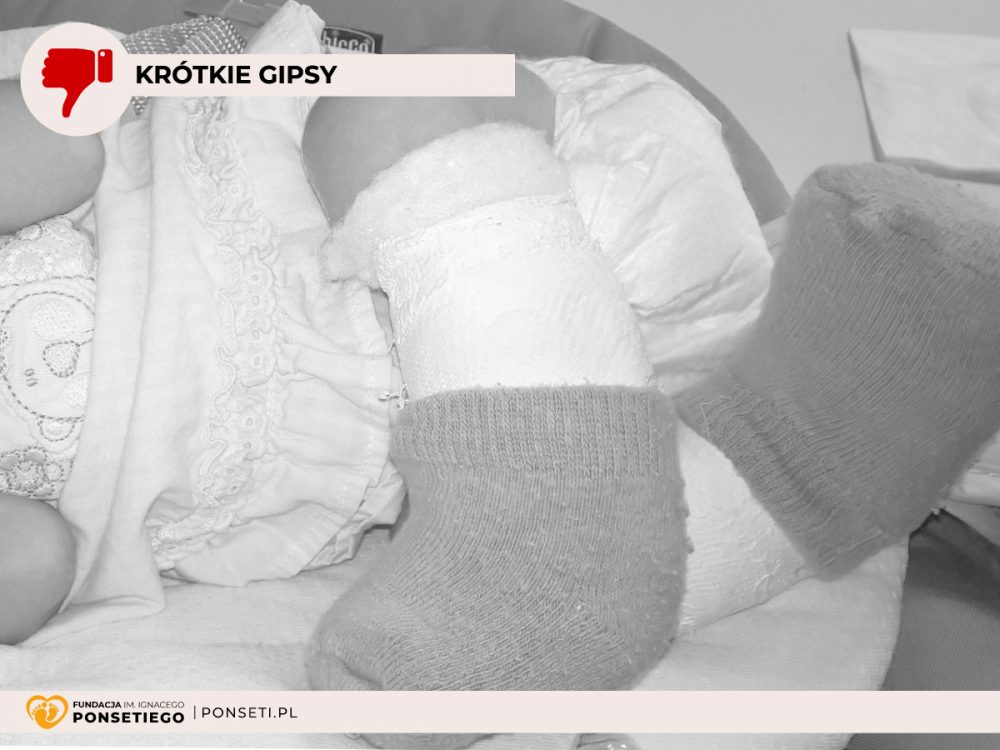
KNEE
The cast used in the Ponseti method is the long leg casts, namely from the groin to the toes, with the knee bent at the angle of 90° (for atypical and/or complex foot: 110-120°). It is important due to the reasons, which have already described above. If there is no angle of 90° in the knee (for atypical and/or complex foot: 110-120°), then the risk of partial foot correction is high. It means that all defect elements will not be fully corrected and they will “get revenge” with RELAPSE faster. A foot will not be fully functional.
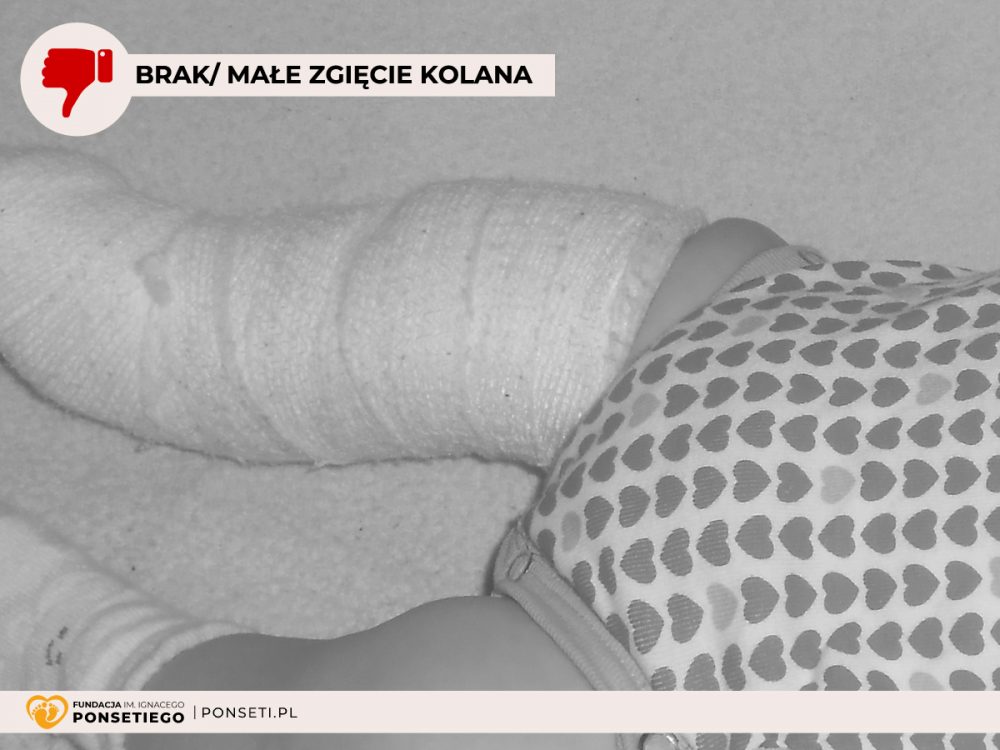

A TUBE ON A LEG
Cast should have the shape of a leg and a foot. If you use traditional plaster in specific quantities and proportions, it is not complicated to get adequate shapes – however, it requires broad knowledge about the defect, good modelling technique and… manual talent. We often find plasters, which we tend to call tubes or pipes. They look as if someone has placed a tube on a child’s leg and bent it in a knee. They do not resemble the shape of a leg, a calf, and a foot. Many additional deformities may occur in such a tubular cast, like even COMPLEX CLUBFOOT.
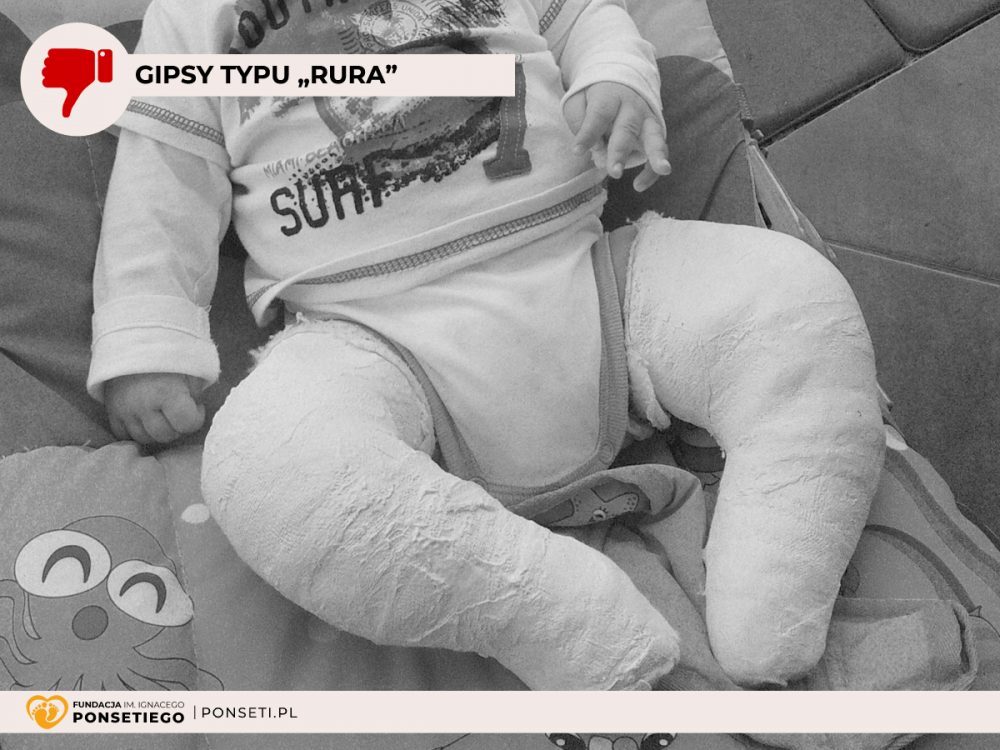
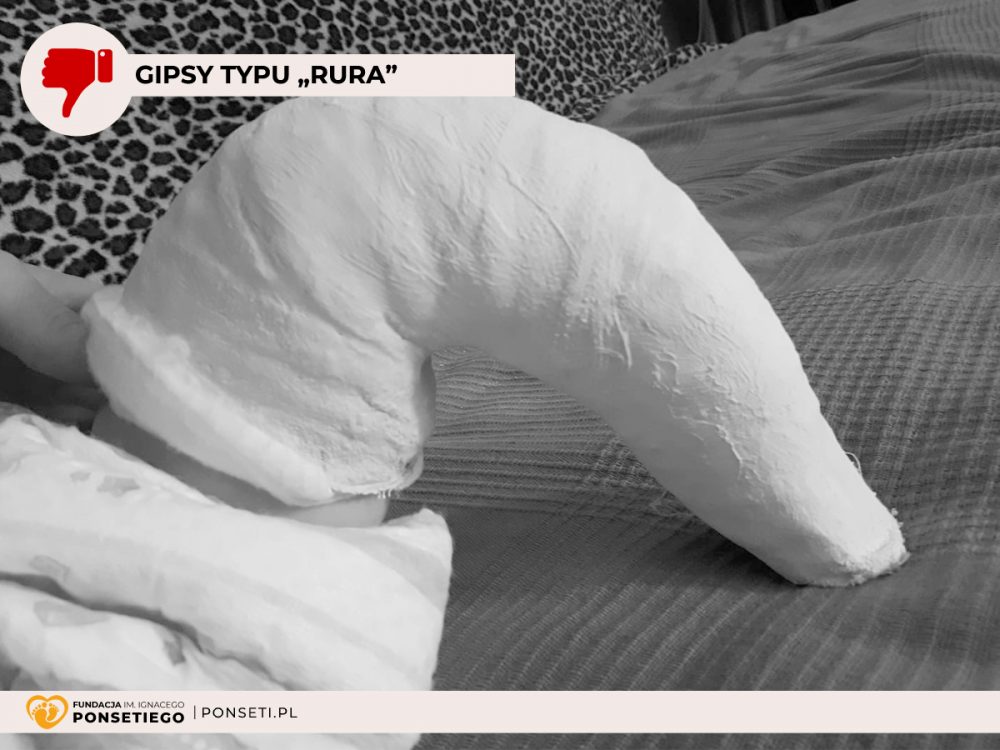
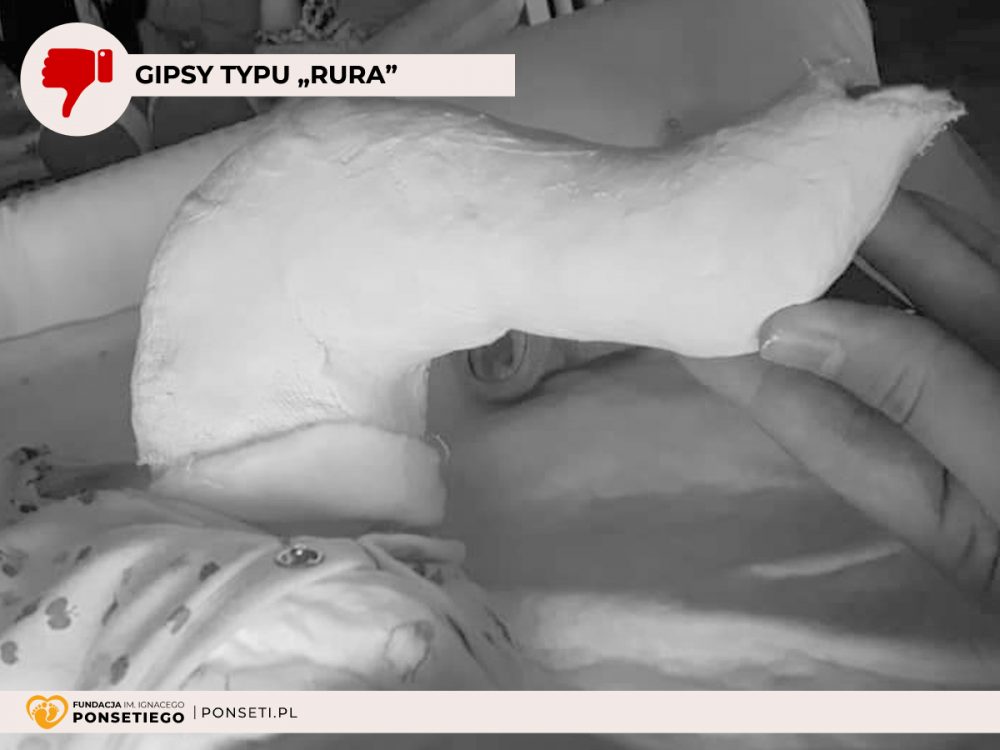

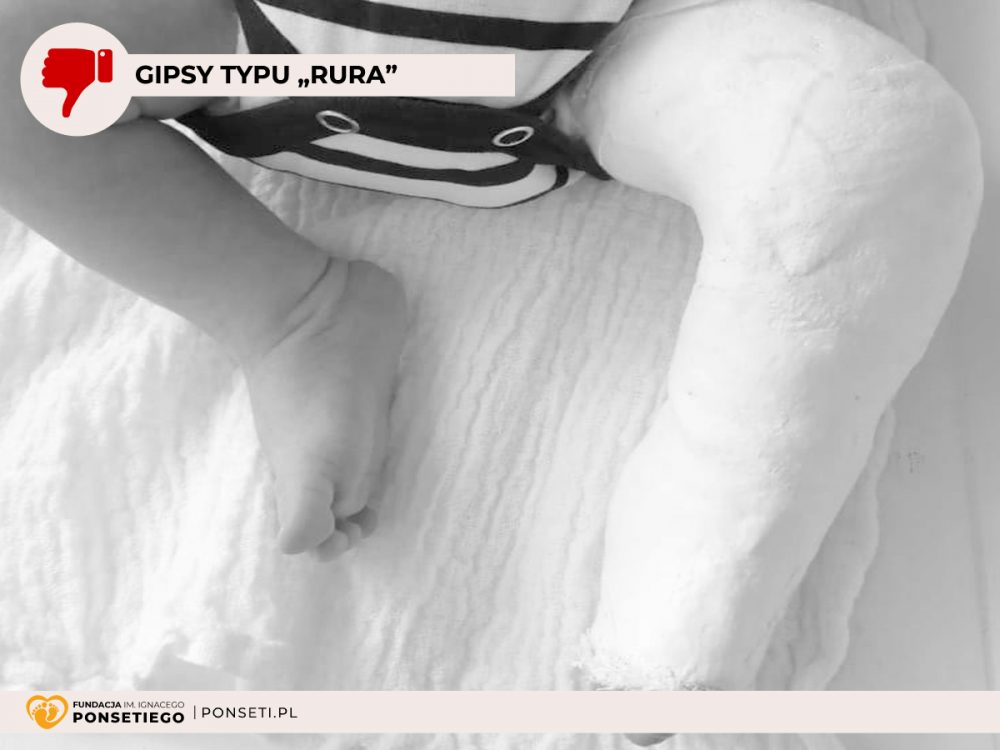
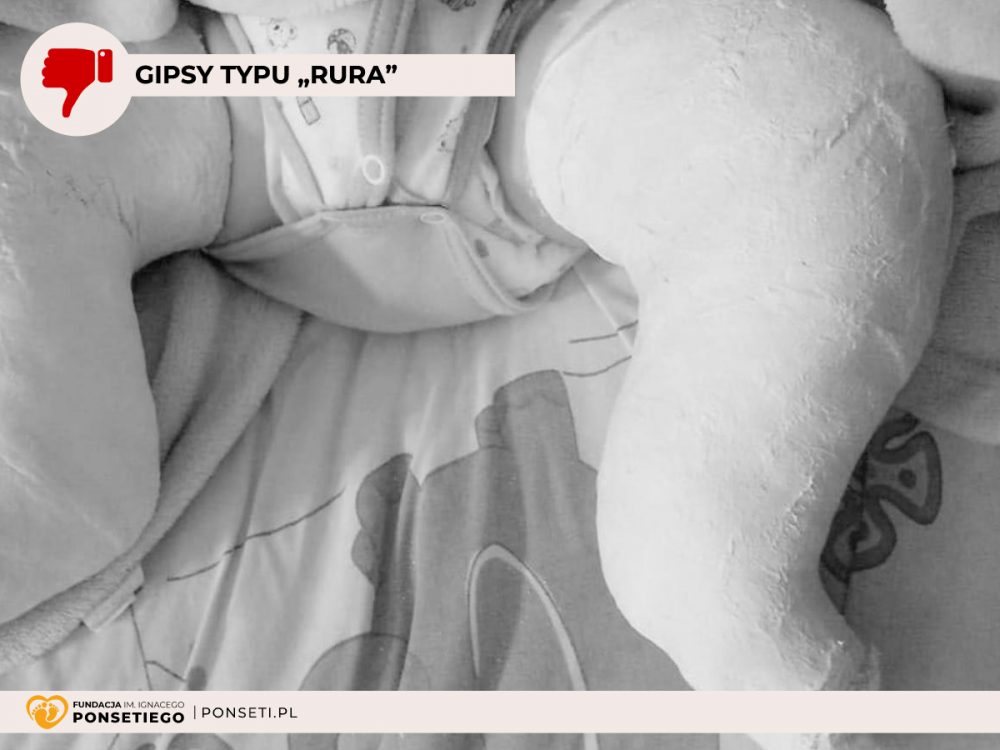
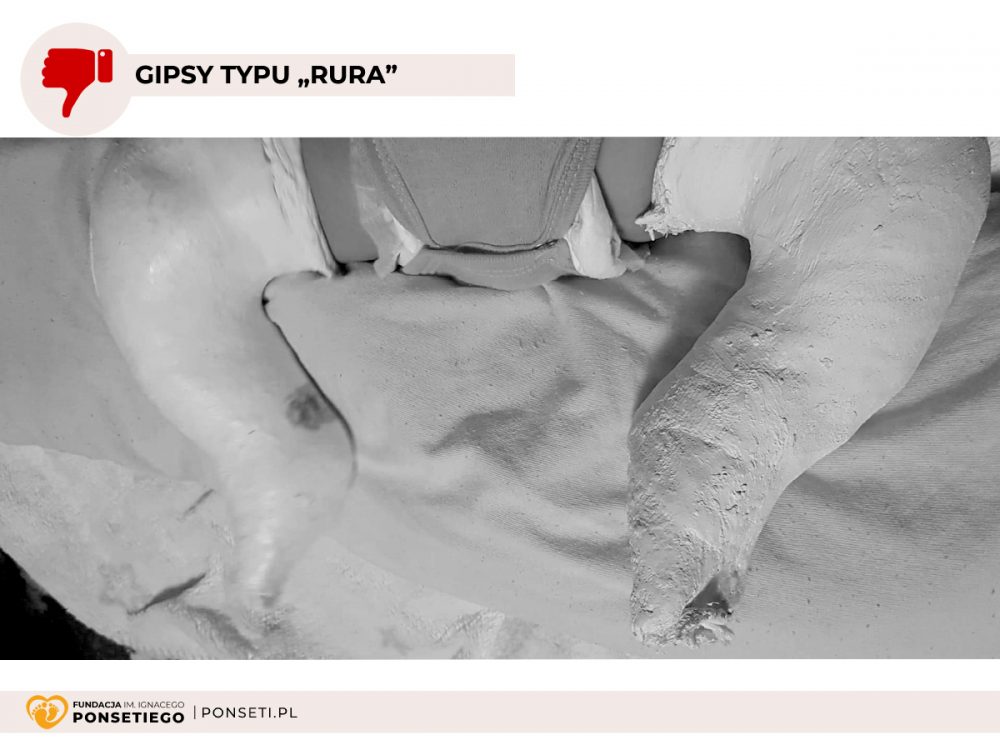
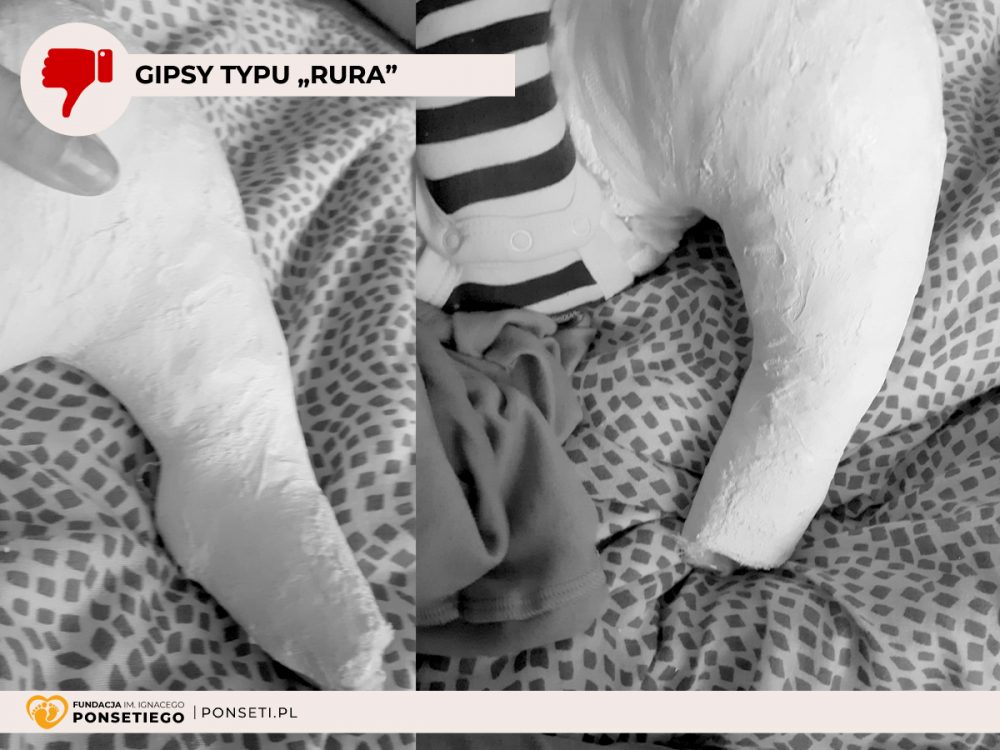



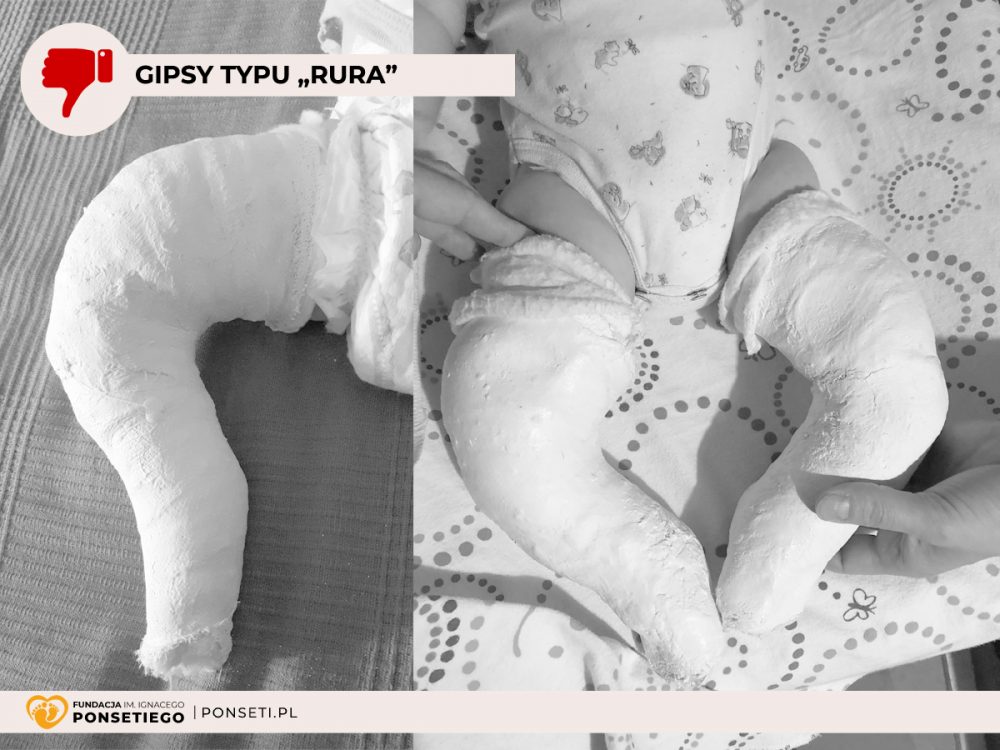
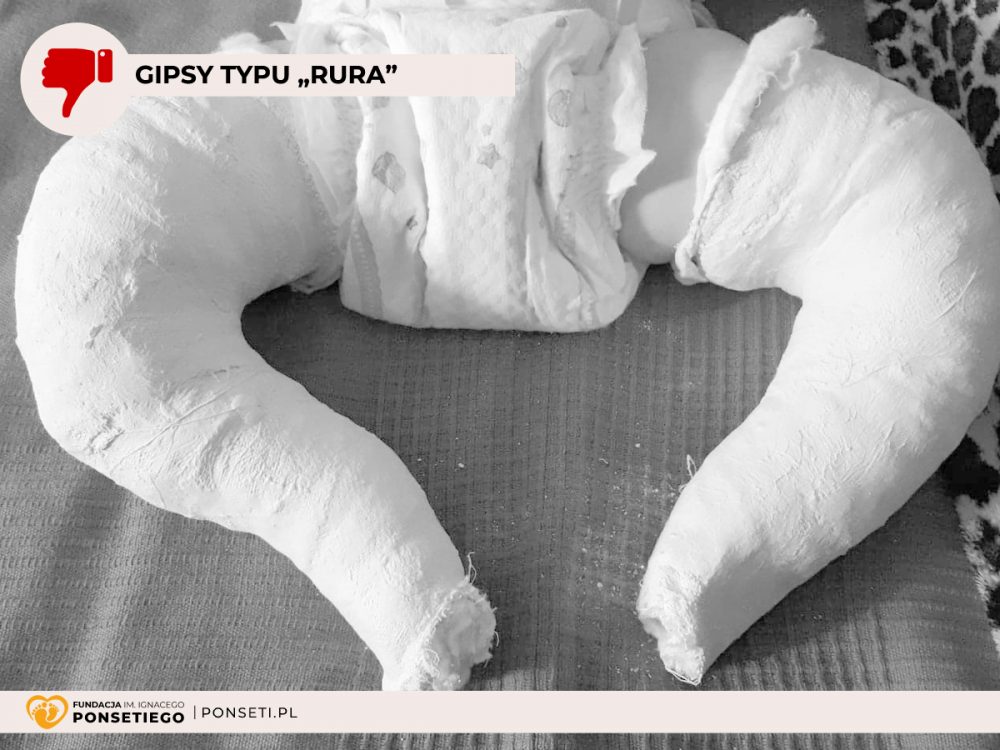
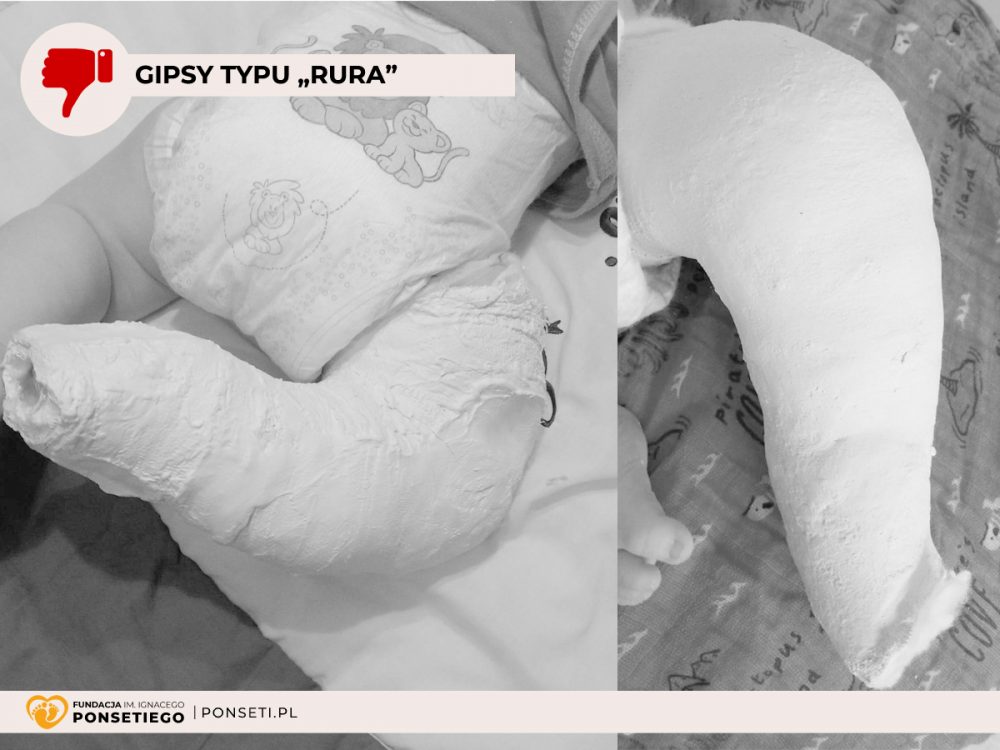
THIN? THICK?
Plaster can neither be too thin – as then it does not keep its form, cracks, and moves so there will be no corrections in this case. Moreover, it cannot be too thick, as it worsens other problems by its weight. Placing a cast on a small child’s leg requires great intuition and experience, analysing so that no hurt will be made by its weight.
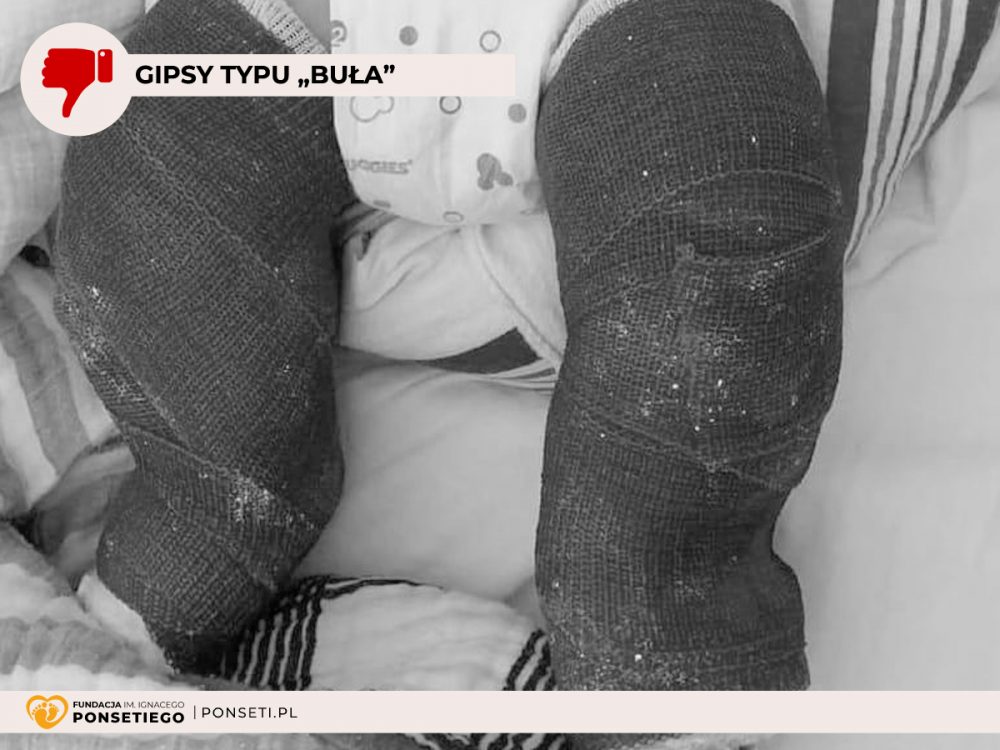
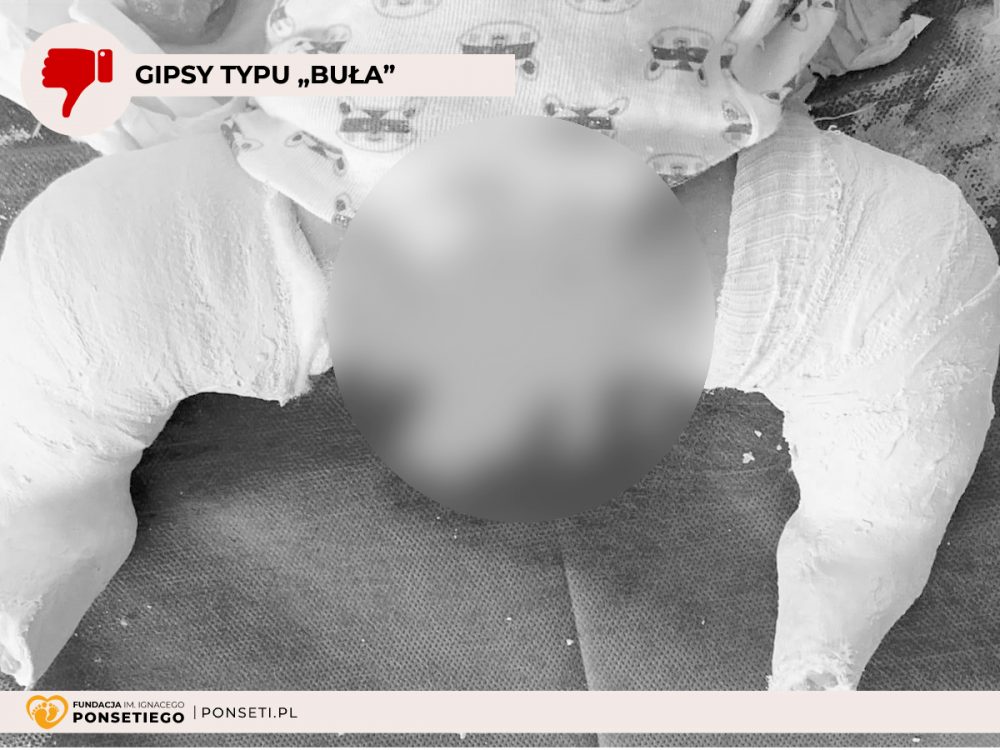
HEEL
When redressment is made before putting a cast, a doctor cannot touch a heel not to stop it. It must be able to move freely under the ankle bone, as the aim of this treatment is to release this bone and reinstate autonomous relations in a foot. However, when you put the cast, the heel should have its anatomically adequate shape. It cannot be flattened, squeezed, pushed upwards, shapeless. It is important to form the foot’s shape, as it “stops” the cast on a leg and prevents it from falling. When a foot is well modelled in the cast combined with a bent knee prevents sliding off the cast. Well modelled foot in a cast also helps to tighten the heel bone a bit and to stabilise it, as it is placed high. As each cast changes foot position, making it look the same as the normal healthy one, the calcaneus before tenotomy should be placed in the neutral or valgus position and also in dorsiflexion equal to 0° or maximum -5°.
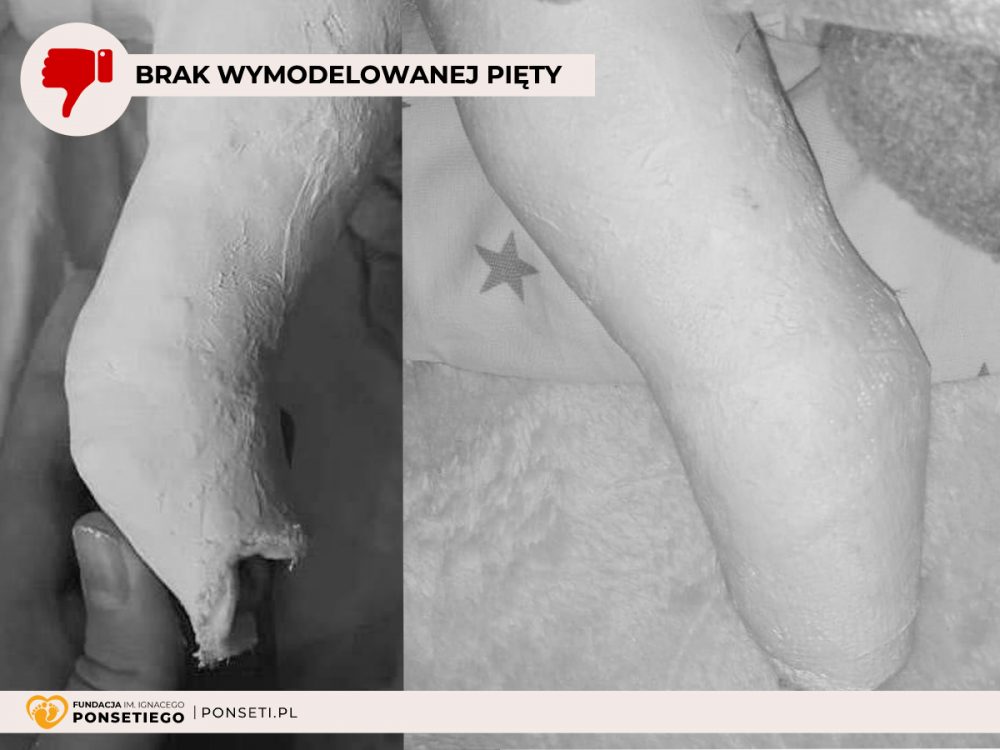
BALOON WITH WATER
Cast should not be too tight. A child’s leg is like a balloon with water: when this balloon is closed in a tight tube, it gets pressure and is painful, the toes swell, a child cries and once the cast is removed, the skin is oversensitive, bedsores appear, there is much swelling and if another cast is placed, it will be a simple way to create COMPLEX CLUBFOOT.
TOES
All toes should be visible in a cast: one next to the other, placed equally (in one line), not curled up, not squeezed, not overlapping, not bent. It is also important to have cast under toes (cast platform). If toes stick out of the cast it means that the person placing the plaster had no knowledge about it. Why is it so important to place the base under the toes? Because then the toes are evenly placed, shortened ligaments and tendons of the foot from the sole side stretch slowly, delicately and evenly. Children have natural tendency to foot grasp reflex, when something is under the toes They try to catch it with toes. They activate foot plantar flexors namely these clubfoot structures, which should be delicately stretched and stabilized at the plastering stage, when the defect is corrected, so that contracted foot soft tissues will not tighten.
When toes are placed in the cast, you can easily identify position of the whole foot. Foot pronation in the cast is not allowed, forefoot pronation! – it causes greater foot cavus, which actually should be corrected and even at the very beginning, namely by using the first cast.
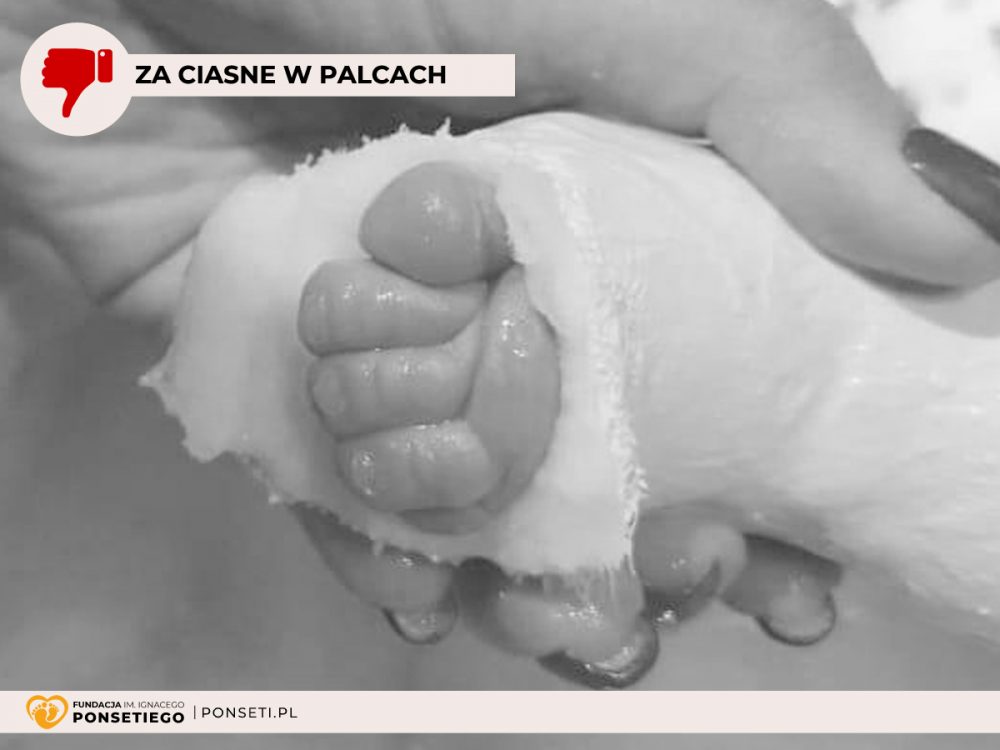

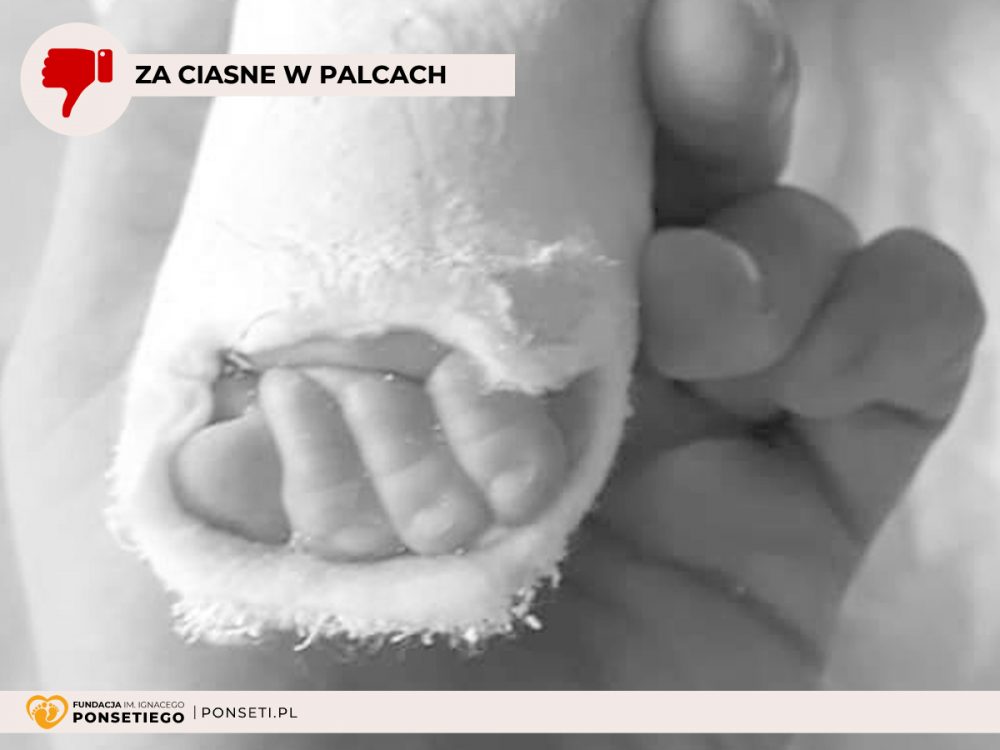
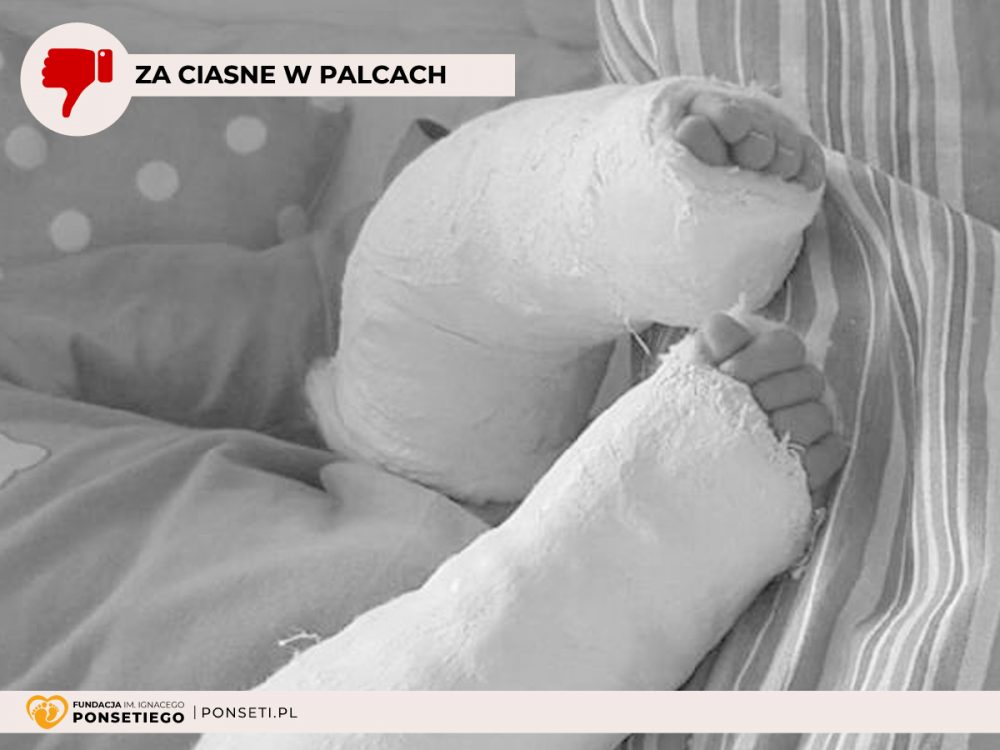

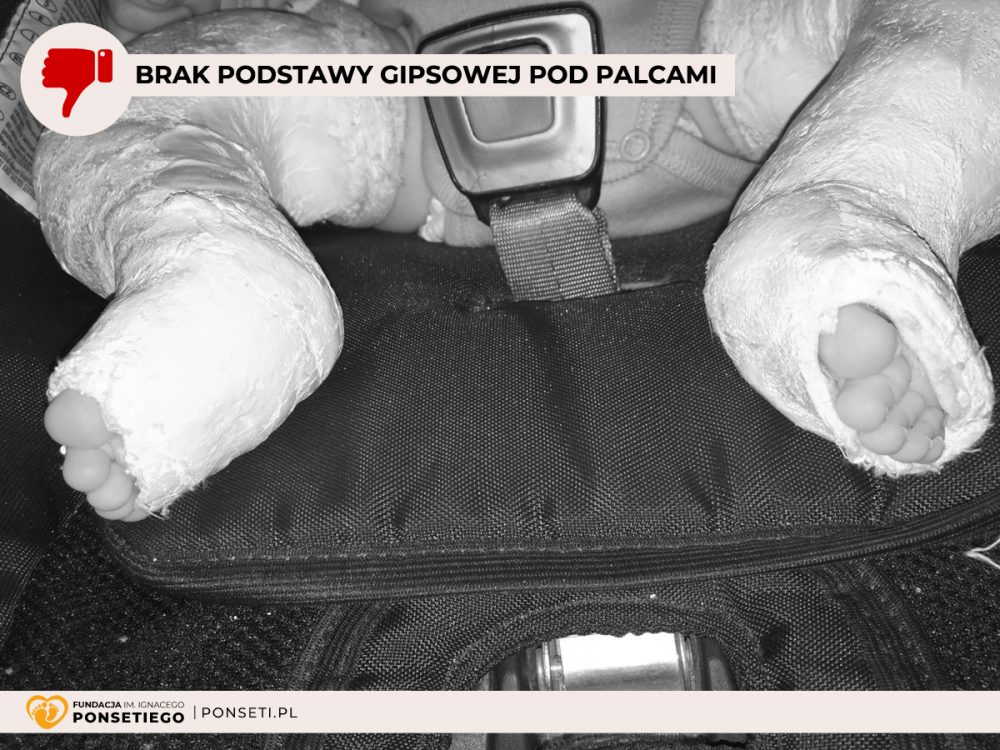
Toes placed in the cast should be uncovered from the top. Connection: the cast platform under the toes + toes moderately uncovered from the top = toe movement upwards, which activate tibial muscles and cause tissue stretching in a foot sole. Moreover, if you do not cover toes, you avoid problems with nails at further stage of treatment. Nails can cause many difficulties while using braces, wearing shoes etc.
IMMEDIATELY!!!
The cast, which slides off, should be removed immediately! The same case applies to too tight cast, which should be removed immediately! Just to avoid further complications.
JOYFUL CREATIVITY
When a doctor does not know a defect, which is inborn clubfoot, he or she does not know correct treatment, namely the Ponseti method and makes caricatured creations. It is obvious that in the majority of cases, which are referred to our foundation, the most frequent explanation of such situation that there is no progress in the cast form, is:
This is foot’s fault, as the foot is difficult, heavy, and resistant. It is not possible.
Unfortunately, each such statement concerns us, if the person, who says so, has adequate know-how and experience in treating this defect by using the Ponseti method. The counter-argument that captures us each time, when we hear such statements as above, we say:

“This is not foot’ fault that it is the way it is. This is the fault of the plastering technique, which is inadequate. If you say that the foot is resistant, heavy, tough, just take a look at your plastering technique. Most probably it is not adequate and sufficient and you have to verify and correct it”
— Dr. Jose Morcuende
The example of such “author’s method” are the so-called frill casts, when a physician or a technician is not able to put a correct cast.
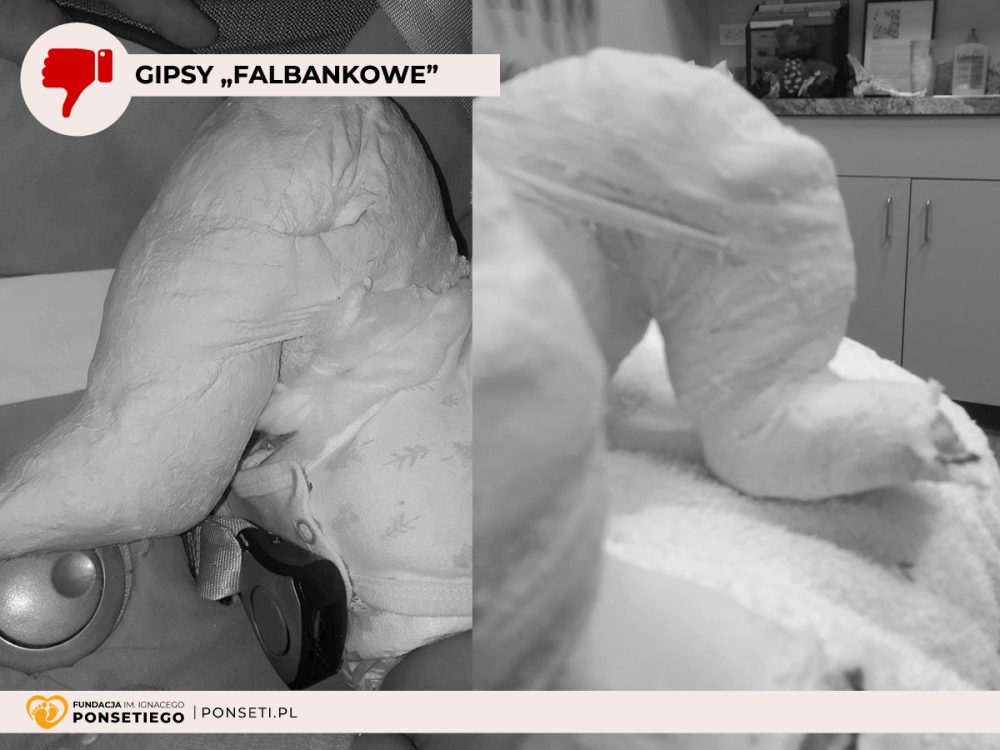
DETAILS…
We have decided “to provide” some knowledge about casts:
- when a doctor plasters a foot (a leg) endlessly, then you have to change a doctor. Each additional cast over 8 pieces causes deformities and maintains the ones, which are present, as well as leads to joint stiffness;
- use of 2 casts, when a foot has been defined as the 3rd or 4th degree of deformity (Dimeglio scale) is also pointless and causes complications, as there are no corrections, no partial correction, and overcorrection;
- when a calf placed in the cast is unnaturally bent outside and it looks like a boomerang in the cast and between the casts – it means that the tibial bone and the fibula have been bent. They are often retracted. Iatrogenic deformity occurs, which is difficult to treat and gives different prognosis.
TWO WAYS
The objective of placing plaster casts is to correct deformities. The aim is to bring the foot back to normal look and functioning. Unfortunately, a foot can be correct by using the cast, but it can also be “damaged” even more, when you use the plaster. Everything is a matter of know-how, experience, intuition, and talent.
KNOWLEDGE:
1. Ponseti I.V: “Congenital clubfoot. Fundamentals of treatment.” (2nd edition)
2. Ponseti I.V., Smoley E.: “Congenital Club Foot: The Results of treatment” (1963)
3. Böhm S., Sinclair M.: “Report of the 1st European consensus meeting on Ponseti clubfoot treatment.”
4. Morcuende J.A, Dietz F.R., Ponseti I.V.: “Radical reduction in the rate of extensive corrective surgery for clubfoot using the Ponseti method.”


